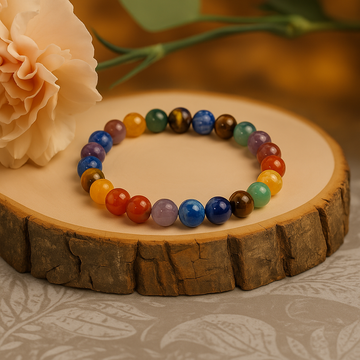Humans have been intrigued by crystals for centuries — not just because of the way they look, but also because of the healing and health benefits that have been given to them. All crystals do carry energy, we believe, so it's wonderful that we're able to tell real from fake crystals. Whether you speak of a pyrite bracelet, zodiac sign bracelet, or health crystal charm, you must recognize that it's real so you're paying for the functionality and the beauty you're getting.
In this detailed guide, we’ll break down exactly how to spot genuine crystals, the differences between natural and synthetic stones, and the common tricks used in the market to mislead buyers. By the end, you’ll be equipped to confidently choose only the real deal.
1. Why Identifying Real vs Fake Crystals Matters
Healing crystals do not show crystals. Those who support them believe that they possess and are able to convey energies that will impact mood, sense, and even physical body. Purchasing a copy crystal is only purchasing glass, resin, or dyed stone without metaphysical energy.
Main Reasons to Explore:
-
Energy Work: Mother nature crystals in themselves hold the metaphysical properties an imbuing healing is rich in.
-
Value for Money: Crystals don't depreciate; copies do.
-
Longevity: Real crystals last decades (or more), while imitations chip, wear away, or break easily.
-
Emotional Connection: Crystals become genuinely personal to people — authenticity guarantees that bond.
2. Materials Most Usually Used in Replicated Crystals
Replicated crystals can be very hard to distinguish by just looking at them. Companies utilize numerous different materials when they replicate the appearance of natural stones.
-
Glass: Slippery but still with clear colours, but typically with air bubbles inside.
-
Plastic/Resin: Light to the touch and warm.
-
Coloured Quartz: Dyed coloured clear quartz so that it appears to be more unusual stones.
-
Synthetic Crystals: Artificial stones which can have perfect structure but without inclusions naturally occurring.
3. How to Know if a Crystal is Real or Fake – Key Indicators
3.1 Temperature Test
Actual crystals are cold to touch even when the surrounding air is warm. Hold one for a few seconds:
Actual: Cooler for a few seconds before warming up.
Fake: Warming instantly.
3.2 Surface and Texture
Nature crystals will be imperfect — small cracks, inclusions, or browning.
Actual: Mottled surface, inclusions, rough-cut edges.
Synthetic: Glassy to an extreme extent, too oily, or too shiny, or too smooth.
3.3 Weight
Natural crystals' minerals are heavier.
Real: Dark tint and nuances of color.
Impostor: Neon-type, too dark, or more even color.
3.4 Color and Transparency
Some of the stones are colored richly, yet they're blotchy and lighter in weight.
Real: Somber tint and nuances of color.
Impostor: Neon-type, too light, or more even color.
3.5 Price Check
If someone is selling an "exceptional" crystal at a price that's too good to be true, be cautious.
4. Real-Life Examples – Common Crystals and Their Imitators
Pyrite (Fool's Gold)
Real Pyrite: Brassy-yellow color, metallic sheen, and heavy density.
Imitation Pyrite: Spray-painted rock or gold-tinted plastic resin.
Amethyst
Real: Ranges from pale lavender to deep purple with natural zoning.
Imitation: Purple glass that has been evenly dyed.
Rose Quartz
Real: Pale pink with sometimes hazy transparency.
Imitation: Pink, usually plastic-like.
Clear Quartz
Real: Few inclusions, slightly cloudy in certain areas.
Imitation: Glass that is blemish-free flawless with no inclusions.
5. Tests and Equipment You Can Do in the Home
-
Magnifying Glass: Examine for small cracks and inclusions.
-
Hardness Test: Use Mohs scale (quartz = 7; will scratch glass).
-
UV Light: Real crystals will fluoresce if you hold UV light on them, but some fake ones won't.
-
Weight Scale: Compare weight against known weights of rocks of a similar size.
6. How to Recognize Impersonator Crystals in Jewellery and Bracelets
-
Bracelet authenticity can be confirmed with:
-
Bead Drilling: imitations are drilled off-center.
-
String Wear: real stones wear down string eventually; fakes are too soft to perform this function.
-
Consistency: same bead size is typical, but minor color or inclusion variations characterize authenticity.
7. Good Sources of Crystals
Purchasing from a reputable company such as Krustallo ensures your crystals are legally and actually mined. We purchase good material from stable sources and hand-sort each stone ourselves. Stay away from those phony sites.
8. Myth about Real and Faux Crystals
Myth: All colorful things are fakes.
Reality: Some actually do have colorful appearances (e.g. malachite), but those that have neon colorings are dubious.
Myth: inexpensive, so it's a fake.
Myth: precious crystals should be handled with respect as precious gems.
Reality: Common crystals will be cheaper; more precious a function of supply, not quantity.
Myth: replica crystals are acceptable to use for energy healing.
Reality: Experts only consider that naturally occurring crystals could possibly have strange vibrations.
9. Taking Care of Your Genuine Crystals
Real crystals will need to be maintained if they are ever to keep their appearance and energy:
Cleaning: Clean in moonlight, short sun, or smudge lightly.
Storage: Store them in soft bags so they don't get scratched.
Avoid Chemicals: Permits and domestic cleaners can ruin crystal surfaces.
10. Last Words
The crystal business prospers, and so do the fakes. If you know.Looking at real vs. fake crystals, you can spend your money on the real, charged stones. Businesses such as Krustallo are dedicated to taking you to genuine crystals that infuse meaning, elegance, and healing energy into your life.
In doubt, remember:
-
Seek out nature's imperfections.
-
Weight, temperature, and hardness to try.
-
Purchase from genuine open vendors.
-
Your crystal search must start on the correct path — for only the real ones hold the magic.



